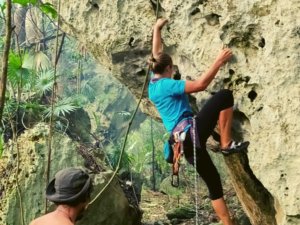Cuba, a captivating blend of unique history, vibrant culture, and stunning nature, offers an unparalleled travel experience. Beyond its rich cultural tapestry, Cuba boasts a distinctive climbing scene dominated by rugged limestone formations.
Viñales, with its 800+ climbing routes, showcases the island's potential to become a world-class sport climbing destination. Here’s what you need to know about Climbing in Cuba:
The Best Climbing Places in Cuba
1. Viñales
Viñales, located within the Pinar del Rio region of Cuba, encompasses the Valles de Viñales, recognized as both a national park and UNESCO World Heritage site. This mountainous area, approximately a 2.5 to 3-hour drive from Havana, is characterized by lush greenery and ancient tobacco farms.
The landscape is dominated by colossal limestone formations called 'mogotes,' hosting over 800 high-quality limestone climbing routes, some extending up to 6 pitches.
The climbing experience in Viñales resembles that of Thailand, featuring steep and challenging flowstone routes, offering a diverse array of holds like jugs, pockets, tufas, and stalactites.
The roots of climbing development in Viñales trace back to 1998 when Armando Menocal, a Cuban-American climber, revisited his homeland and discovered the immense climbing potential within this limestone haven.
In the subsequent year, he successfully encouraged a team of climbers from Colorado, including Skip Harper, Craig Luebben, and George Bracksieck, to venture to Cuba and commence climbing development.
This collaboration with the Cuban climbing community, initially composed of spelunkers who had ingeniously set up a few top-rope crags near Havana without specialized gear, was pivotal.

While the earliest climbing routes in Viñales were established by the American team, this partnership marked the beginning of an extensive gear donation program.
This initiative empowered Cuban climbers to lead and contribute significantly to the local climbing development, shaping the history of Cuban climbing.
Where to climb in Viñales?
Viñales offers three primary climbing areas within close proximity to the town, making it convenient for climbers to explore:
Mogote del Valle
Situated closest to the town, Mogote del Valle is a prominent limestone formation covered in lush jungle. It's a focal point for local climbing development, featuring about 70% of all climbing routes in the region.
The routes here cater to various preferences and styles, ranging from single to multi-pitch climbs, technical face climbing to tufa-laden routes, with difficulty levels spanning from 4 to 8b+.
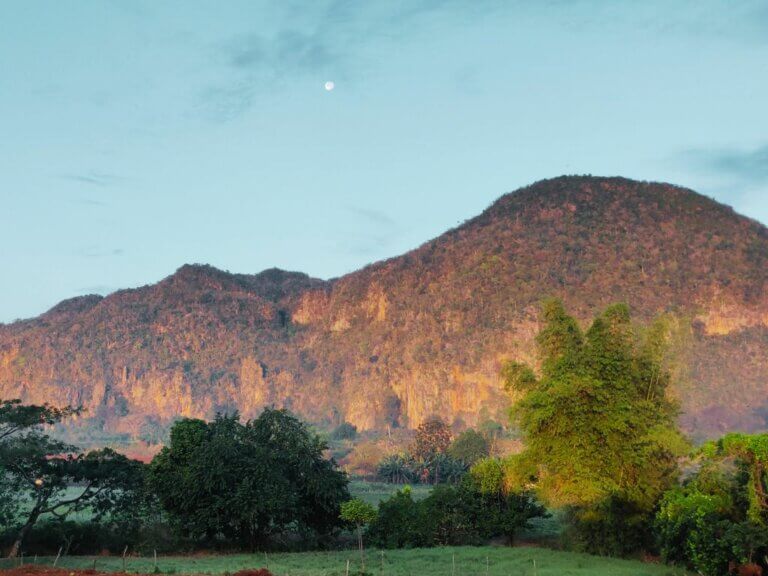

La Cueva Cabeza de la Vaca (La Cueva)
This cave in the Mogote del Valle area serves as a local gym, offering challenging overhanging routes set against stunning waterfalls and mesmerizing stalactites.
Climbers should have a confident climbing level of at least 6c to fully enjoy this area, as there are only a few easy routes.
La Costanera
Ideal for hotter days, La Costanera is a striking north-facing limestone cathedral featuring high-quality single and multi-pitch routes graded from 5th to 8th grade.
The 'Jagueyana' crag within La Costanera is particularly attractive for climbers in the 6s and 7s range, with a diverse array of climbs and notable routes like 'Ana Banana' (6c).

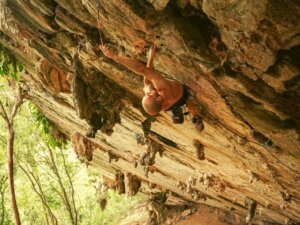
El Palenque
El Palenque stands out as an indulgent climbing area with impressive rock formations, easy access, numerous classic routes, and a unique vibe, including a bar-turned-disco inside a cave near the parking area.
It's a must-visit sector for climbers seeking a bit of fun and challenge. Viñales offers an abundance of high-quality climbing options, allowing climbers to stay for extended periods without exhausting the variety of available routes.
Viñales offers an abundance of quality climbing opportunities that allow for a longer stay without exhausting the variety of routes.
2. Playa Jibacoa
For those new to Cuba, it's highly recommended to dedicate a few days to explore lesser-known climbing destinations across the island.
Consider heading to Playa Jibacoa, a charming fishing village situated in the Mayabeque Province of Cuba, just about a 40-minute drive from Havana.
This serene locale offers unspoiled beaches and picturesque countryside, inviting visitors to enjoy activities such as swimming, snorkeling, diving, hiking, or simply basking in the sun.
Jibacoa's beach is accompanied by a medium-sized limestone crag, featuring around 50 single-pitch sport routes ranging from 5 to 7c.
Unlike the steeper routes in Viñales, these climbs are approximately 35 meters long and offer a more relaxed climbing experience. It's an excellent choice for a few laid-back days of climbing, and if you desire a quick break, a short walk to the sea is all it takes.
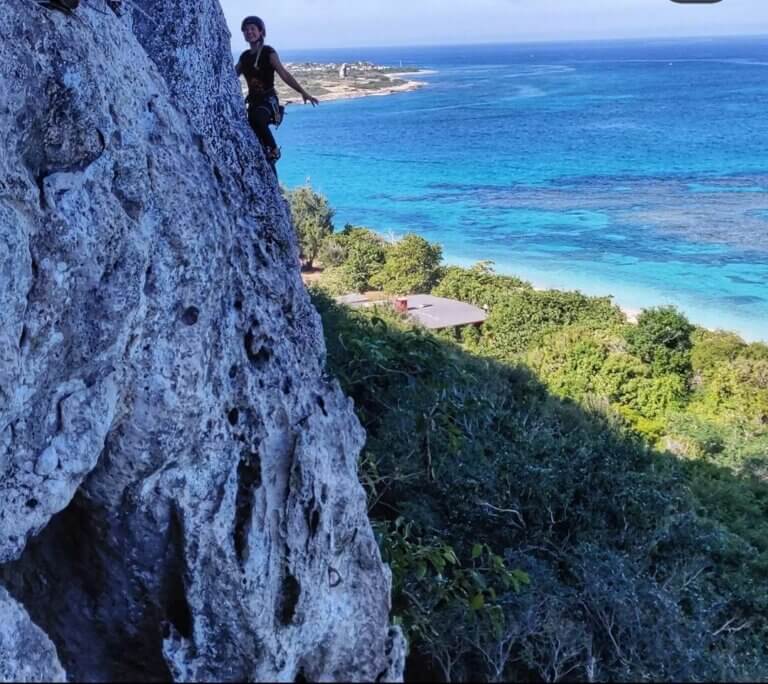
3. Holguín and Gibara
Holguín province in Eastern Cuba beckons adventure seekers with its rugged, mountainous landscape, concealing numerous limestone cliffs. This region comes second only to Viñales in terms of potential for setting up climbing routes.
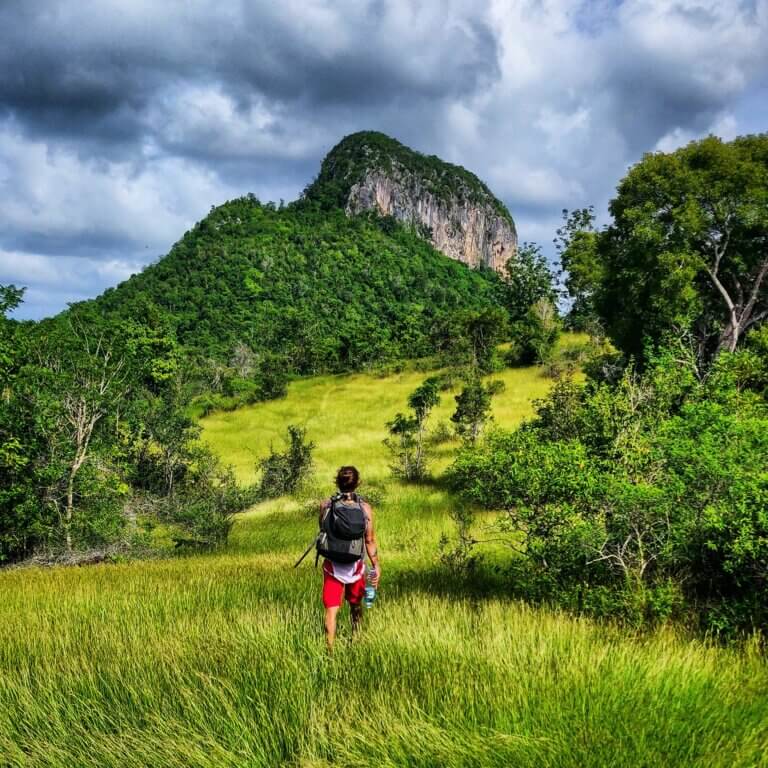
Near the towns of Holguín and Gibara, you'll encounter impressive crags boasting several hundred climbing lines, some reaching up to grade 8a. The limestone formations here are stunning, attracting a burgeoning community of local climbers involved in bolting these routes.
While reaching most of the crags may require a slightly longer walk compared to Viñales, often up to an hour, the experience guarantees high-quality routes and an authentic sense of seclusion.
If you have the time, exploring the towns of Holguín and Gibara, along with the nearby beaches, is highly recommended, offering a glimpse of the genuine and authentic side of Cuba.
For a successful trip to Holguín, it's advised to connect with the local climbing community through Cubanture beforehand to ensure you have the latest and most accurate access information.
Best Time to Visit
The best time to visit Cuba for climbing is during the dry season, which typically runs from November to April. This period provides the most favorable weather conditions, with lower rainfall, mild temperatures, and lower humidity.
The pleasant weather during these months ensures a more enjoyable climbing experience, allowing you to fully appreciate the beauty of Cuba's climbing areas.
Additionally, the dry season aligns well with the international climbing community's preferred climbing months, making it a great time to meet fellow climbers and immerse yourself in the climbing culture of Cuba.
Keep in mind that specific months within the dry season, like December to March, are particularly popular due to the comfortable weather conditions.
Where to Stay?
For an authentic Cuban experience, consider staying in 'casas particulares,' which are licensed private rooms available for rent within locals' homes. Breakfast is often included in the price.
Both Havana and Viñales offer numerous options for casas particulares, so you can choose to book online, request them via Cubanture or explore and select one in person. Seeking recommendations from locals is a great idea. To satisfy your hunger, be sure to visit Paladares, family-operated restaurants often located in residential homes. Here, you'll enjoy traditional Cuban cuisine in a welcoming and homely ambiance. While some Paladares in Havana resemble restaurants, they still offer a delightful array of traditional Cuban dishes to savor.
What To Bring Along?
When heading to Cuba for a climbing adventure, it's essential to pack the right gear and essentials to ensure a safe and enjoyable trip. Here's a list of items to bring along:
Climbing Gear:
- Harness
- Helmet
- Ropes
- climbing shoes
- chalk bag
- belay device
- Carabiners
- Quickdraws
- Slings
Clothing:
- Moisture-wicking shirts
- Climbing pants or shorts
- Socks
- Light jackets or layers for cooler evenings
- Rain gear (jacket and pants)
- A hat
- Sunglasses
- Sunscreen
Safety Equipment:
- First aid kit
- Multi-tool
- Headlamp with extra batteries
- Personal medications
Personal Items:
- Personal hygiene items
- Toiletries
- insect repellent
- a travel towel
- Mobile phone
- Camera with memory cards
- Charger and a power bank
- spare batteries
Ensure your equipment is in good condition and well-packed for easy access during your climbing adventures in Cuba. Always prioritize safety and double-check your gear before starting your climbs.
FAQ
Cuba offers a distinctive climbing experience due to its limestone-dominated landscape, diverse rock formations, and a blend of cultural and natural beauty.
Viñales Valley is the most popular and renowned climbing area in Cuba, known for its limestone mogotes and extensive range of climbing routes.
Sport climbing and traditional climbing are prevalent in Cuba, with various routes catering to different skill levels and preferences.
Yes, Cuba has emerging climbing areas like Holguín and Gibara in the east, offering diverse routes and the potential for exciting climbing experiences.
Conclusion
In summary, Cuba is a captivating blend of history, culture, and natural beauty. The island's limestone landscape offers a unique and promising climbing experience. Viñales, with its vast array of climbing routes, showcases Cuba's potential to be a premier sport climbing destination. For adventure enthusiasts, exploring Cuba's climbs promises an unforgettable and thrilling journey.
This might also be interesting for you
Climbing off the beaten track in Cuba - camping at the climbing rock of Jaruco
Vor mir sehe ich eine matschfreie Weggabelung. Endlich! Der Schweiß...
Read moreExkursion zum neuen Kletterspot in Cojimar
Behutsame setze ich einen Fuß nach dem anderen auf und...
Read moreKlettern in Kuba – Die Höhlenwelt von Viñales
Einen riesigen Stalaktit im Klammergriff hänge ich an der Route...
Read more